Thai vs. Vietnamese food is a topic that not many people pay attention to if they are not cooking up Asian dishes for their meal. However, if you’re looking to experiment with exotic Asian cuisine, it may be wise to look into two Southeast Asian most iconic representatives.
This article will explore the main differences that set these two countries’ cuisine apart. In addition, I’m excited to bring you some of the most popular dishes from each country so you can experience Southeast Asian cuisine right at home.
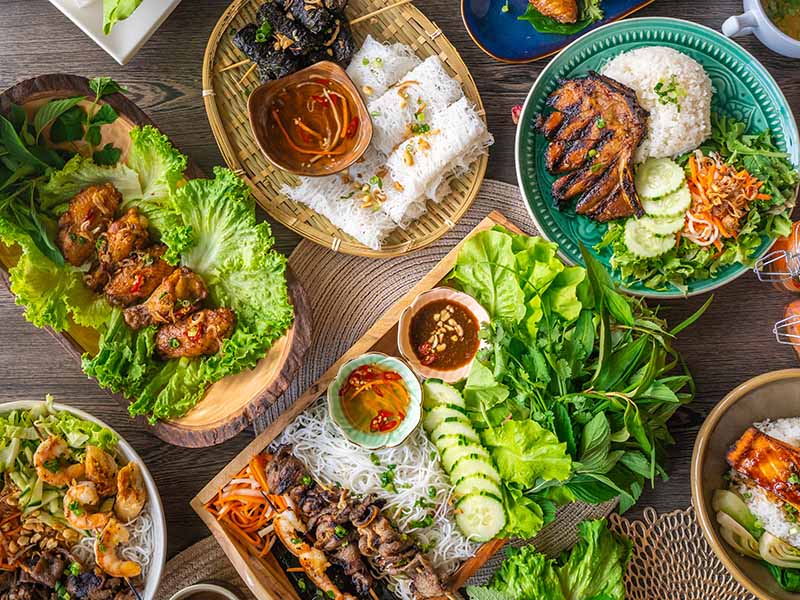
Thai Cuisine 101
To understand a country’s cuisine, you may want to start with the key features that dictate dishes’ flavor. Furthermore, you may find your preference in these categories to determine whether Thai delicacies fit your taste bud or not.
Thai cuisine usually falls into four categories of Yam (spicy salads), Tom (boiled dishes), Tam (Pounded dishes), and Gaeng (Curries). Although some Thai specialties may fall between the borders of these categories, you can still distinguish the cooking methods.
Neighboring countries also help shape Thai cuisine as Laos cooking influences the Northern Thai while Cambodian cuisine affects southern Thailand. In addition, the east of Thailand also adopts some of the cooking styles or dishes of Vietnamese cuisine.
Furthermore, Thai cuisine also receives influences from the Royal family, dating back to the Ayutthaya period (1351 – 1767). Many Thai dishes let the spiciness run wild and utilize various coconut products as an additive to improve or set the tone for the recipes.
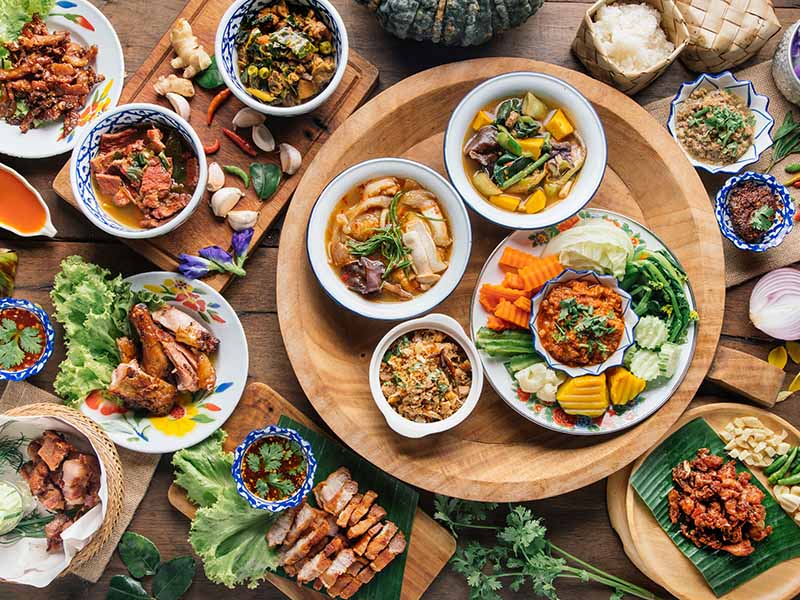
Things You Need To Know About Vietnamese Cuisine
Vietnam is a fascinating Southeast Asian country with diverse cultures. Therefore, each area has different seasoning techniques that result in a wide range of tastes. Let’s discover what Vietnamese delicacies can offer.
Many Vietnamese dishes often reflect a clear taste. Since the country received a lot of influences from Chinese and French cooking, Vietnamese cuisine tends to balance Yin and Yang. Typically, Vietnamese try to season dishes in a way so they can go well with rice.
Vietnam also has regional cuisine, with three areas having the biggest impact: the North, South, and Central. Each region has a different method of interpreting the ingredients and adapting them to cooking.
Internationally, the world considers Vietnamese cuisine one of the healthiest cuisines because it provides balanced meals in both flavors and nutrients. In addition, various Vietnamese specialties can encompass many countries’ cooking techniques into one plate.

Differences And Similarities Between Thai And Vietnamese Food
Let’s jump into discovering the differences between Thai and Vietnamese foods. Remember, this section is a compilation of differences that you need to know between Thai and Vietnamese delicacies.
Similarities Of Thai And Vietnamese Foods
One huge common between Thai and Vietnamese cuisines is using rice and noodles to pair with dishes. Therefore, many specialties need to be flavorful to spice up the bland rice and noodles. Another thing to note is that both countries consider fish sauce as the key element in cooking.
In some cases, newcomers to Asian dishes may find it challenging to differentiate between Thai and Chinese cuisine because of their similarities. However, each Asian country always has distinct features in its cuisine.
As for ingredients, both nations aim at using fresh ingredients but at different stages of the cooking process. Locals of Thailand and Vietnam also share the same herbs like garlic, ginger, and basil to set the tone for many delicacies.
Explore the beauty of Thai cuisine through some of the most fantastic street foods in Phuket.
Differences Between Vietnamese And Thai Foods
The differences between Vietnamese and Thai foods are quite obvious to notice. Therefore, allow me to give you an in-depth look into the distinct features of these two neighboring cuisines.
1. Origin And Culture
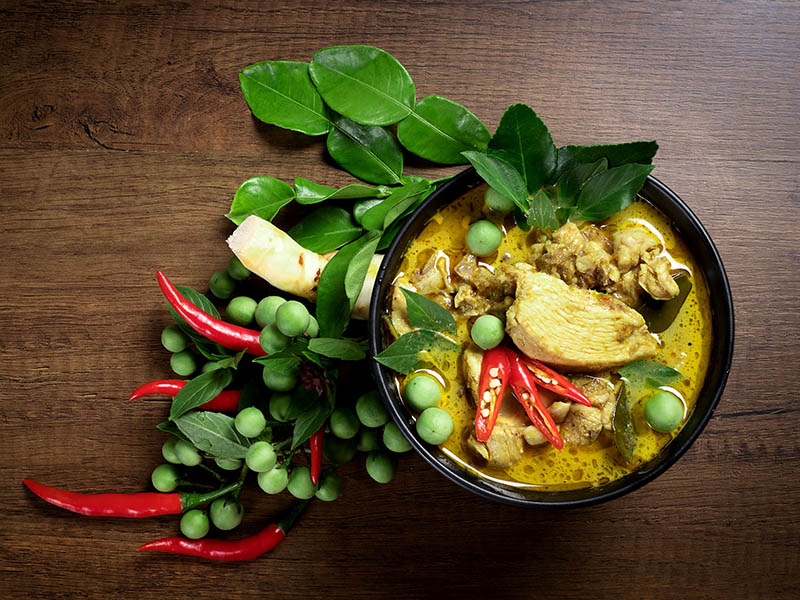
In terms of origin, Vietnam’s cuisine is heavily influenced by Chinese cuisine due to the long colonial period. Furthermore, the French also placed their mark on Vietnamese cooking during the 20th-century when the country was still a colony of France.
In addition, Vietnamese cuisine also has influences from Cham, Malaysia, and Cambodia. The most obvious example is the curry spices that came to the country through Malaysian and Indian traders. Unlike Thailand, Vietnam doesn’t have a national religion.
Thailand is a country that has adopted Buddhism as its national religion. On average, 93% of Thai people practice Buddhism. Thailand also possesses unique cooking techniques derived from small ethnic groups in the Northeastern area.
When it comes to Thai cuisine, people often relate to spicy curries as a country’s staple. In addition, Thai culinary culture also illustrates a wide range of cuisine from neighboring countries like Laos, Myanmar, Malaysia, and India (1).
In short, Vietnamese and Thai cuisines both receive influences from neighboring countries.
2. Flavors

In general, Thai foods utilize a generous amount of chili. Sometimes, it makes the dish unbearably spicy. Since Thai cuisine receives heavy influence from Indian culture through Buddhism, many Thai dishes usually have a bold and sharp taste from various condiments.
The spices often go directly into Thai dishes to work as additives to help enhance the overall flavor. Thai chefs try to bring a balance of salty with spicy, sweet, and sour tastes. In some cases, one flavor may dominate the rest, but the dish will also have other mentioned tastes.
Vietnamese foods tend to be milder in comparison with Thai dishes. It is mainly because Vietnamese cooking methods focus on light and balancing flavor. Although the South of Vietnam usually utilizes more sugar in their cooking, the main purpose is to create a harmonious mixture.
People often compare Northern and Southern foods in Vietnam because of the numerous differences in flavors and cooking traditions.
Furthermore, the Vietnamese often orient many dishes around the five-element philosophy. A concept that helps balance a meal in both flavors and health benefits.
In general, Vietnamese cuisine tries not to focus on a particular flavor. With a diverse culture, Vietnamese food can be salty, spicy, bitter, sour, or sweet. As for the chili, people only feature it as an optional additive for an extra kick of heat.
Uncover the flavor of Vietnamese cuisine through these wonderful dishes.
3. Ingredients
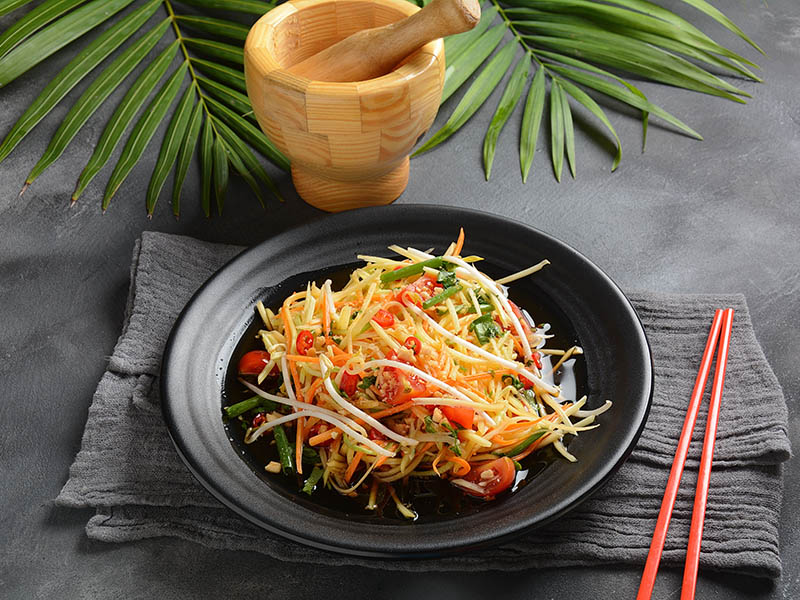
Thai cuisine is all about utilizing fresh ingredients. Thanks to a tropical climate, you may find many vegetables incorporated in many dishes. In addition, Thai people often revolve many delicacies around shellfish, fish, and crustaceans.
As for the goat, mutton, and lamb meat, they are not a popular choice for Thai locals, except for the country’s southern region. Another thing to remember is that Thai cuisine utilizes a lot of fish sauce in its cooking.
Vietnamese foods encompass a wide range of inexpensive ingredients that reflect different cultures and living conditions. The south often relies on the Mekong river to get its necessary ingredients. Northern Vietnam usually features fresh vegetables and well-loved Vietnamese fruits for their meal.
The Central of Vietnam usually has fewer ingredients; instead, the area often illustrates a saltiness in every meal. Furthermore, the South Vietnamese prefer rice as the main focus while the North uses noodles (2).
In short, Thai cuisine takes advantage of its diverse local ingredients to cook up beautiful specialties. As for Vietnamese cuisine, people usually optimize the ingredients used in their diet with different elements from each region.
4. Cooking Methods
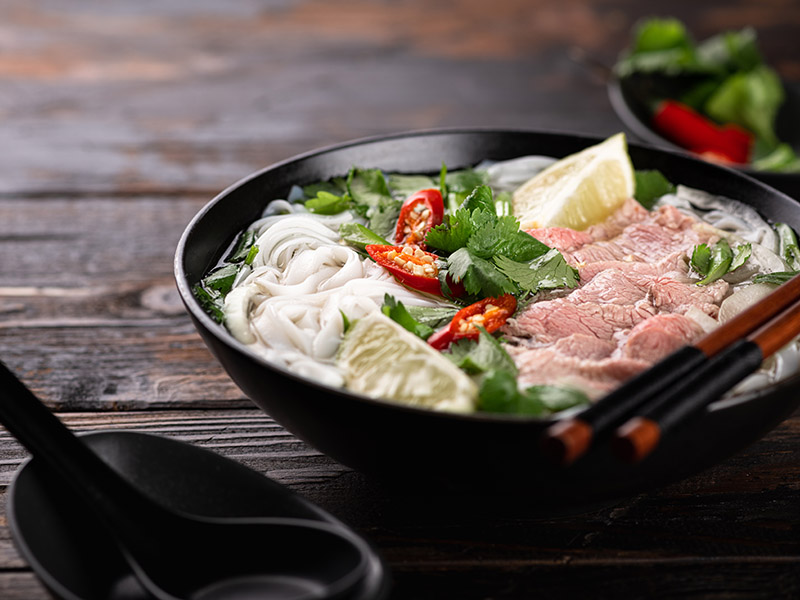
When it comes to cooking methods, people tend to compare Chinese and Vietnamese cooking. The Vietnamese utilize a wide range of methods like stir-frying, deep-frying, boiling, and steaming. However, the chefs prefer simmering with low oil to produce less greasy delicacies for accompanying rice.
Despite possessing a variety of cooking methods, the final aim of Vietnamese cuisine is to preserve the freshness and original flavors of ingredients. Typically, Vietnamese recipes are simpler than Thai because they incorporate fewer ingredients with easy processing steps.
The cooking method of Thai mainly consists of stewing (Toon), grilling (Yang), salad (Yum), and steaming (Neung). However, the country later adopted stir-frying (Pad) and deep-frying (Tod) as ways of processing foods from China.
Generally, both Thai and Vietnamese cooking try to keep all the steps as simple as possible to preserve the ingredient’s flavors.
Understand more about Thai exotic cooking through these wonderful specialties.
Spices Of Vietnamese Versus Thai Varieties
Unlike Thailand, Vietnam’s cooking tends to have a variety of additives to customize the dish to the consumer’s own will. The spiciness is often mild, and people can freely adjust using sate, chili oil, or fresh chilies.
As for Thailand, the spiciness is predetermined from the cooking stage; you don’t need any additives to manipulate the taste. Thai locals often throw in a lot of chilies during the cooking process to make the dishes more flavorful.
Vietnamese people tend to add herbs and fresh vegetables later on as an additive to improve the texture or taste.It’s different from Thai cuisine since it incorporates herbs directly into the dish while cooking.
In addition, the Vietnamese also add spices separately to personalize the dish’s flavor. In return, Thai cuisine immerses the spices directly into cooking and requires no further adjustments.
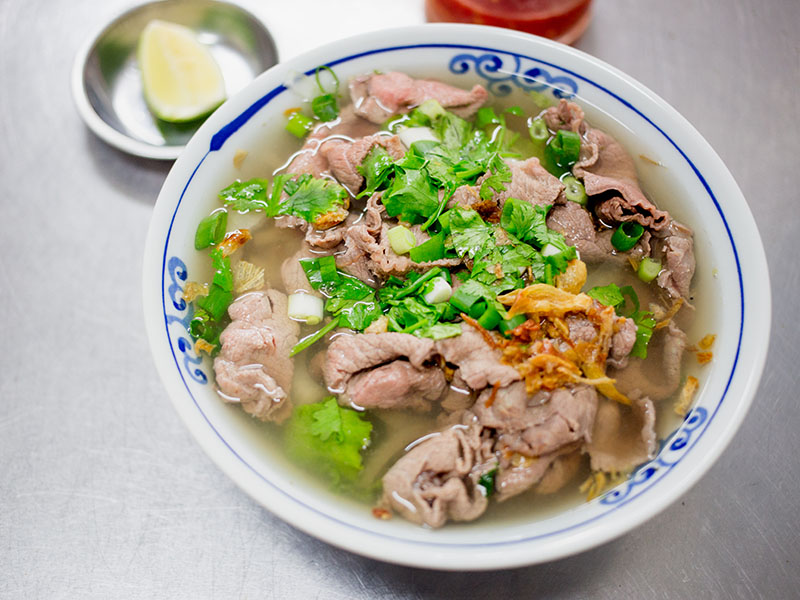
Does Vietnamese Food Or Thai Rely On Chopstick For Serving?
Typically, Vietnamese foods often use bamboo chopsticks due to the cuisine being associated with Chinese. In Thailand, chopsticks are not common utensils since people often utilize spoons and forks for eating. Thai locals usually use chopsticks for Chinese-style noodle soup.
Judging by the difficulty level, you may find using chopsticks more challenging as it’s hard to manipulate the utensils at first. However, I believe with a little bit of practice, you will soon become an expert at handling Asian food using chopsticks.
Some Vietnamese Dishes To Cook Up At Home
Now that you understand the two countries’ differences and similarities in cuisine, you may want to look into the most popular dishes. Here I have some iconic Thai and Vietnamese cuisine representatives to try right at home.
1. Phở (Vietnamese Beef Soup With Rice Noodle)
When it comes to Vietnamese foods, the first thing that comes to anyone’s mind is Pho, a decadent bowl of beef soup with rice noodles. Although the dish may look easy because of the clear broth, it’s no easy task to nail it on the first try.
Commonly, you want to cook beef bones for an extended amount of time to extract all the goodness. Use the beef stock liquid as your base to combine spices like cinnamon, cloves, and star anise.
As for the flat rice noodles, you can easily find them at Asian supermarkets to help cut down on the preparation time. For serving, I suggest slicing the beef as thin as possible; this allows the beef to cook thoroughly once it comes in contact with the hot broth.
Pho is a must-try for newcomers to Vietnamese cuisine.
2. Bánh Xèo (Vietnamese Pancake)
Banh Xeo is undoubtedly a popular dish in Vietnamese cuisine. The specialty often appears as street food, with Vietnam’s central being the most famous area for its small yet crispy Banh Xeo. The delicacy is a simple concept of folding a thin layer of fried batter with various ingredients.
The batter for Banh Xeo is simple to find as the flour mixture appears at many Asian supermarkets. In addition, I suggest adding coconut cream into the flour with scallion, salt, and water. Ideally, the batter should be runny.
People often use pork and shrimp for the filling of Banh Xeo. Furthermore, the recipe also requires you to throw in some bean sprouts for extra texture. The Banh Xeo alone tastes bland, so make sure you accompany it with sweet and sour fish sauce for the best experience.
3. Gỏi Cuốn (Vietnamese Spring Rolls)
Goi Cuon, or Vietnamese Spring Rolls, are a staple of Vietnamese cooking. If you think boiled pork and shrimp with rice noodles are boring, let Vietnamese spring rolls change your mind. These simple ingredients are all in place of soft rice paper.
After boiling the pork and shrimp, you want to slice them thinly and lay the meat over the lettuce and rice noodles. You need to wet the rice paper first, then assemble the ingredients. You may want to practice rolling a couple of times to get the hang of it.
Furthermore, I suggest you look more into Vietnamese beverages to execute a full Vietnamese course. It shouldn’t take too much effort for you to prepare.
The key thing of Goi Cuon is to pair them with a viscous sweet and nutty peanut butter sauce. Another popular option is a sweet and sour fish sauce which is easier to make. As a friendly reminder, you don’t want to place too much filling because the rice paper may burst.
Thai Delicacies To Whip Up
Here are some ideas for your next Thai dishes. You will soon realize that Thai cooking is relatively different from Vietnamese. If you love spicy specialties, Thai cuisine should be your top priority for the next meal.
1. Khao Pad (Thai Fried Rice)
Originating from the Central of Thailand, Khao Pad is a wonderful way of handling your leftover rice. This Thai fried rice recipe is a mesmerizing combination of various condiments to take the rice to another notch.
Traditionally, people utilize eggs to combine with chicken thighs to provide a sufficient amount of protein in Khao Pad. The essential point of Khao Pad is to crank up the heat while stir-frying the rice. It helps infuse a nice smokiness to the rice and ingredients.
I suggest accompanying Khao Pad with some refreshing Thai refreshments to quench your thirst while enjoying the delicacy. It’s the best way to experience the full flavor of Thai cooking styles.
Finally, I highly recommend preparing Nam Prik Pla, a special Thai sauce that consists of fish sauce, lime juice, and red chilies. The sauce helps Khao Pad get that extra note of saltiness and spiciness, bringing out the authentic Khao Pad taste.
Khao Pad is perfect for making full use of leftover rice.
2. Pad Thai (Thai Stir-Fried Rice Noodle)
Pad Thai is a must-try dish of Thai cuisine with smokey stir-fried rice noodles with various decadent ingredients. Although noodles already appeared in Thailand long ago, people only invented Pad Thai in the 20th century.
Aside from the rice noodles, Thai locals combine chicken with shredded carrots, bean sprouts, and eggs. People usually stir-fry the elements in a deep pan to infuse the dish with a signature smoky flavor.
No Pad Thai is complete without featuring the sauce, a combination of fish sauce with tamarind extracts, soy sauce, and lime juice. Once the sauce fully coats the ingredients, you want to serve Pad Thai with a sprinkle of crushed peanuts.
3. Tom Kha Gai (Thai Chicken In Coconut Soup)
Tom Kha Gai is a rich Thai soup with a creamy yet tangy and sour flavor. The chicken is super tender to pair with a murky soup. Tom Kha Gai is a fun recipe to experiment with coconut cream so you can level up your cooking.
This Thai soup combines Thai curry paste with mushrooms, chicken breasts, and chicken stock. In addition, you may want to use galangal (southeast Asian condiment) and lemongrass to set the tone for the soup.
Of course, it’s not a Thai dish without including chili to enhance the spicy level. Finally, don’t forget to add a squeeze of lime juice for that refreshing sourness.
FAQs
Here are some questions that people may still wonder about Thai and Vietnamese foods. I hope this FAQ section satisfies your curiosity about the cuisine between Thailand and Vietnam.
Which Cuisine Is Your Pick To Cook On The Next Meal?
I hope this article helps you identify the differences between Vietnamese and Thai cuisine. These two neighboring Southeast Asian countries may share their border, but their cuisine completely sets them apart.
Comment below which one is your favorite delicacy of each country. I’m more than happy to know about your Asian cuisine experience. If you know someone about to travel to Thailand or Vietnam, send this article to them, so they know what to expect from the cuisine.
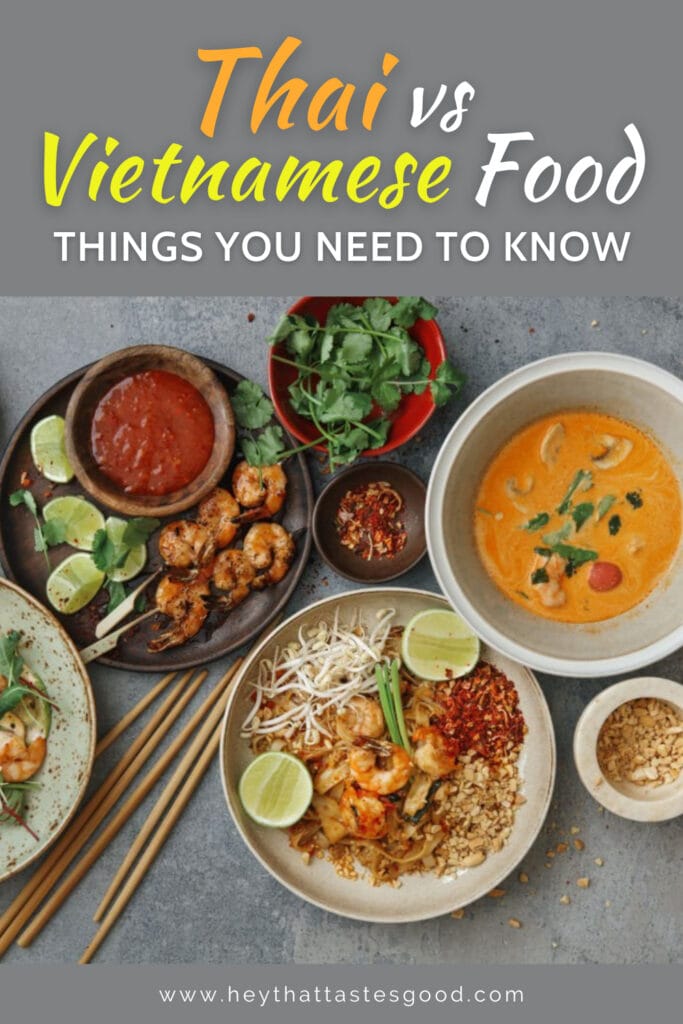
References
- En.wikipedia.org. 2022. Thai cuisine – Wikipedia.
- En.wikipedia.org. 2022. Vietnamese cuisine – Wikipedia.


Truc Tran (Kris)
Expertise
Home Cooking, Meal Planning, Recipe Development, Baking and Pastry, Food Editor, Cooking-video Maker, Asian Food Content Creator, Vietnamese Food Evaluation Expert
Education
Program: Diploma of Hospitality (Commercial Cookery)
Focus: The culinary program included a Certificate III in Commercial Cookery, a Certificate IV in Kitchen Management, and a Diploma of Hospitality Management. This education provided a comprehensive blend of theoretical and practical training in finance, sustainability, diversity, and human resources management.
Program: Culinary Arts at Kendall College (Australia Branch in Sydney)
Focus: Explored global cuisines, and developed entrepreneurial abilities to manage a successful food business, along with acquiring essential language, math, computer, and communication skills for success.
Program: Certificate of Vietnamese Cuisine Head Chef
Focus: Master traditional and modern Vietnamese cooking techniques.
Truc Tran, or Kris, is an accomplished food editor with extensive training in hospitality and culinary arts, including a deep focus on Vietnamese cuisine from various prestigious institutions. She possesses over nine years of experience, developing her expertise in global cuisines and blending traditional Vietnamese cooking with contemporary trends to create engaging and educational content.
She also has a rich educational background, including a Diploma of Hospitality from TasTAFE and a Bachelor of Arts in Culinary Arts from Kendall College’s Sydney branch. It enables her to offer unique insights into meal planning, recipe development, and food culture, making her articles and cooking videos both informative and appealing.